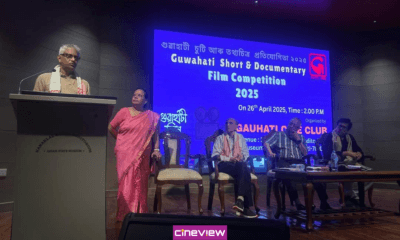Film Reviews
Joy Hanu Man: The Hero Amongst Us
“Joy Hanu Man” depicts a hero from us, yet not of us

I took an early morning train to Guwahati on the 18th of October, as it was Friday and a new Assamese movie was releasing in the theatres. Watching a film in a cinema hall is still a rare experience for many of us from small towns in Assam, as there aren’t many halls around. Many old cinema halls shuttered during the 2000s and 2010s, and Assamese cinema went through a tough time during this period.
A new cinema hall is in the pipeline in my hometown, and people like me are eagerly waiting for it to open, so we can enjoy films nearby. The craze for cinema is so immense that people in my hometown travel 40 km to Tezpur just to catch new releases. I remember taking my mother to watch Bidurbhai at a Tezpur cinema hall; she hadn’t seen a film since the hall in our hometown shut down. With new, thought-provoking Assamese films being released, people are willing to travel the distance to experience them in theatres, as the excitement is at its peak.
In recent times, with the release of films like Bidurbhai, Pikhaas, Local Kung Fu 3, and more, people are flocking to theatres to experience the magic that films create and the variety of stories revealed on the big screen. With this renewed craze comes the responsibility for filmmakers to provide audiences with stories that are worth the effort people make to come and watch a movie at the cinema hall
The recent release of Joy Hanu Man is certainly worth that effort. It tactfully deals with a narrative that provides the audience with the satisfaction of coming to the theatre and experiencing a long-lost depiction of heroism in Assamese cinema. This hero comes from an ordinary life and possesses great physical strength, yet he falls short because he is as common a person as the audience. He is a hero from us, yet not of us.
Joy Hanu Man, which is a very upfront political film, reflects the issues of this time. Directed by Himanshu Prasad Das, who is known for bringing bold, real, and relatable narratives to the screen, Das’s strength lies in his ability to convert a narrative into something more believable and practical without losing the essence of its commercial appeal.
After reaching Guwahati at 10:30 am, I went directly to the cinema hall to book tickets for the first show at 11:15 am, as I couldn’t wait to see what’s new in Das’s latest attempt. From the very beginning, what captivated me was the background music. It is so thoughtfully planned and shaped by Basshole that I was wowed by its impact on the film.
In the first sequence, when the bag is stolen by those kids and the bomb blast occurs, the background music appositely sets the intensity and pace of the scene. As the story unfolds through news channels and the university hostel comes into view, the background music blends seamlessly with it. It doesn’t overwhelm but matches the rhythm of the film. Certain tracks, particularly when the hero emerges or during the sequence where the villain appears, remind me of 1970s Bollywood tracks, where specific music cues justified the characters’ appearance.
This film certainly has a touch of Bollywood drama that I couldn’t help but notice. The way the college drama showcases—with the protagonist seeing a girl in the canteen, followed by a soundtrack and a romantically hyped song in his imagination, and then that imagination interrupted by the canteen boy Jeetu with humour—creates a distinctly Bollywood romance feel. This is justified because, in college, people often experience life as if it were a Bollywood film. One of the characters even specifically mentions that things are not the same as in Hindi films.
Das didn’t just evoke the nostalgia of Bollywood romance; he also incorporated relatable and catchy social media content for the audience. Whether it’s Das’s popular poem “Ei Suwali” or the reel that has been circulating with the phrase “He Ram Prema Nanda,” these elements resonate well with the audience. On the same note, while the humour sometimes felt a bit forced, it still worked for the audience; people laughed at those lines, which certainly benefited Das and the film.
The film also captures the essence of heroism, which is rare to see in this new wave of cinema, where ordinary narratives are more accepted and appreciated. However, Das’s decision to take that leap of faith by showcasing the hero wearing a typical costume and going to save the world distinguishes this film from others. Das knows very well how to present a hero.
When the protagonist dons that costume for the second time at the hostel and walks through the corridor, it evokes nostalgia for the iconic heroes of cinema. The hero is portrayed with an unapologetically muscular and strong nature, making it impossible to question the authenticity of this character. This portrayal is justified through the narrative, and I won’t question it for the sake of questioning.
Along with the hero, the two supporting characters—the senior (played by Joy Kashyap) and the journalist (played by Amrita Gogoi)—are portrayed very tactfully. They are depicted as the masterminds behind the hero, making him feel heroic without actually elevating him to that status. That’s where the writers’ (Santanu Rowmuria, Adhiraj Kashyap, Himanshu Prasad Das) work on the subject is evident.
The characters are crafted in such a way that the audience gets a chance to laugh at the hero, as he seems clueless at many moments yet making people aware that he is the one who can practically achieve it. The writing is tight, allowing these three primary characters enough time to develop their characteristics throughout the narrative.
The pace of the narrative is heightened by the cinematography, particularly where the camera follows the situation and characters rather than simply being a spectator. The shaky shots during the sequence of stage performance, when Hanu Man goes out to save the child, and at various points in the narrative, made me feel the tension more intimately than ever. In these instances, static or non-shaky linear shots might not have been as effective. The decision to take that leap is where the director of photography (Chandra Kumar Das, Nihar Ranjan Gogoi) and director’s perspectives and clarity of thought are evident.
The film is also elevated by the compelling performances of the actors, who blend seamlessly with the characters that the writer and director envisioned. Specifically, the character of the canteen boy Jeetu (played by Nabajyoti Nath) is portrayed in such a way that his absence in the second half is quite jarring for the audience.
For this, along with the writer and the director, actor Nabajyoti Nath deserves special recognition. He is such an eye-catcher that when he is on screen, people can’t help but focus solely on him. He knows how to draw the audience’s attention through his expressions, gestures, and the way he delivers his dialogue, which captivates viewers. Although his screen time is limited, the impact of his performance is impressive. I can’t help but reiterate that he is undoubtedly the show-stealer of this film.
Apart from this, the other performances are also worth praising. The protagonist, Hanuman (played by Siddharth Boro), is presented beautifully on screen; he has the aura of a typical muscular, powerful hero that people appreciate in commercial cinema, and he truly owns the film. Although the rawness of his acting doesn’t work in certain sequences, the other two actors, Joy Kashyap and Amrita Gogoi, who have been constantly by his side, save many of the scenes and make Hanuman’s reactions believable for the audience with their counter-reactions. Amrita Gogoi’s performance is not only believable; it demonstrates how capable an actor she has always been
However, in many instances, the film could not hold its ground. It didn’t feel like it was lacking in anything, but I couldn’t help but think that the second half felt rushed. When the character of Prabhu (Mr. Kalita) enters the picture, the film begins to lose its appeal for me, as the attempt to make the story more unpredictable seems to overshadow the narrative that had been taking shape until his entrance. For me, the character seems to appear out of nowhere; the writers didn’t introduce him at all, which makes his reveal as the villain seem even stranger. This reflects how filmmakers are often focused on creating unpredictability instead of staying true to the story.
It’s disappointing how different characters are introduced only to be discarded once their purpose is fulfilled, without giving them depth or presence in the film, which is a relatively weak point of the writing. The characters of the college friends, the police inspector, the hero’s love interest, the opposition leader, and others are all underdeveloped and used without justice.
After the villain’s arrest, the story felt so rushed that it took me a moment to process what Das was trying to convey. The film touches upon many things, but in the second half, Das fails to justify any of them, making it feel like a mixture of elements that don’t make much sense. The story develops with a predictable arc but then abruptly shifts its focus to a new villain, which hardly worked. Making a story unpredictable shouldn’t be the filmmaker’s aim; rather, it should be about justifying every subplot that leads to the climax. For me, that’s one of the major elements that didn’t work in this film.
At the same time, the caution that a filmmaker needs to exercise while depicting sexual assault scenes is something this film could have been more mindful of. These are very sensitive topics that filmmakers are dealing with. Since they are creating films for public consumption, scenes like these could trigger certain viewers, and the filmmakers need to be mindful of this. Whether it’s Kooki, a poorly handled film about sexual assault, Bidurbhai, or now Joy Hanu Man, all fail in their attempts to portray sexual assault effectively. One does not need to show it explicitly; rather, the essence of it should be conveyed if it must be included in the film.
It needs to be reiterated that this film is of our time and deserves the audience’s attention. The recent turnout at the cinema for this film has not been great, which is concerning. The film has been made with significant effort to appeal to the commercial and entertainment preferences of the general public, so it deserves our attention. The audience is urged to make their way to the cinema and witness the new world that Himanshu Prasad Das is striving to create. This film, with its unique vision, deserves to be seen and appreciated by us.

 Opinion5 months ago
Opinion5 months agoMorality, Obscenity and “Mou Bihu”

 Film Reviews11 months ago
Film Reviews11 months agoSundarpur Chaos or Chaos in Director’s Vision

 Film Reviews1 year ago
Film Reviews1 year agoLocal Kung Fu 3: Is Assamese Comedy Evolving?

 Film Reviews1 year ago
Film Reviews1 year agoBidurbhai’s Shocking Caricature of Queers: Painful but Not Surprising

 Film Reviews1 year ago
Film Reviews1 year agoFor Assamese cinema to flourish, movies like Sikaar are necessary

 Film Reviews1 year ago
Film Reviews1 year agoBasumatary’s Jiya is a Beacon of Hope for Assamese Cinema

 Film Reviews1 year ago
Film Reviews1 year agoBhoot Jolokiya: Just like the chili, the movie too lingers long after it’s over

 Film Reviews11 months ago
Film Reviews11 months agoAbhimanyu: Questioning the system, one frame at a time






















Pingback: Abhimanyu: Questioning the system, one frame at a time - Cine View
mrinmay
November 17, 2024 at 5:54 pm
Joi hanuman flopped gol beya lagey